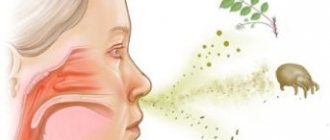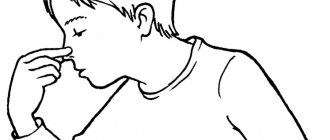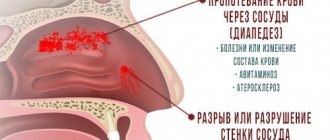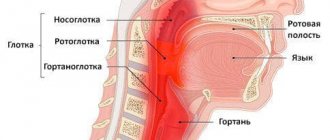Why can your nose hurt during and after a runny nose?
You should know! Pain in the nose can not only accompany a runny nose, but also persist for several days after it.
The causes of this symptom may be:
- swelling of the nasal mucosa at the acute stage of rhinitis (the exception is its viral form, in which there may be no pain);
- stress on tissues and blood vessels due to constant nose blowing;
- allergic reactions , which can be both the cause of the runny nose itself and a consequence of the use of medications in its treatment;
- inadequate and untimely treatment , which leads to uncontrolled spread of mucosal edema.
It hurts to breathe when you have a cold
Impaired breathing, and even more so chest pain in the presence of pathology in the throat, is not a typical symptom for common infections.
In this regard, you should be attentive to the appearance of pathological signs in the chest and, even more so, breathing problems. The combination of such symptoms with a sore throat can indicate a variety of serious pathologies and acute (sometimes even emergency) conditions.
Of course, not all breathing problems are a serious problem.
For example, typical rhinopharyngitis (inflammation of the mucous membrane of the nose and pharynx) is accompanied by a runny nose, sneezing, discomfort or soreness of the throat. At the same time, it may also be difficult for the sick person to breathe through the nose due to swelling of its mucous membrane. However, this symptom is not at all dangerous for the patient.
The only exception to this rule is small children who are prone to developing laryngeal spasms due to ARVI. For such children, restoring normal nasal breathing, especially at night, is an important part of preventing laryngospasm.
To help the patient restore nasal breathing, it is recommended to rinse the nose with salted water or regular saline (0.9% sodium chloride solution), or periodically moisturize the nasal mucosa with special sprays (Aqualor and Aqua Maris for the nose).
In case of very severe swelling that completely blocks nasal breathing, you can use vasoconstrictor drops, for example Naphthyzin, Galazolin, Otrivin, Sanorin, etc.
Acute inflammatory processes in the respiratory system
Breathing problems begin more often when the inflammatory process due to viral and bacterial infections is localized in the lower respiratory tract. A person may feel that it is difficult for them to breathe and have chest pain due to such diseases as:
- Tracheitis (inflammation of the trachea),
- Bronchitis (damage to large and medium bronchi),
- Bronchiolitis (inflammation of the bronchioles - the terminal branches of the bronchial tree),
- Pneumonia (damage to the lung tissue itself).
Only a doctor can accurately diagnose “bronchitis” or “pneumonia”, since a reliable sign of any of these diseases is only auscultatory data, that is, the nature of wheezing in the lower respiratory tract, which the doctor hears when examined with a phonendoscope.
Knowing which wheezing and in which parts of the respiratory system are characteristic of a particular disease is exclusively a medical matter.
Typical signs of inflammation of the lower respiratory organsDiseaseMain symptomsTracheitisStenosing laryngotracheitisBronchitisBronchiolitisPneumonia
| Burning, chest pain felt in the upper part of the chest in the midline (behind the breastbone), dry cough. |
| A hoarse voice, a rough barking cough, and it is difficult for the patient to take a breath. |
| A dry cough at the beginning of the disease is replaced by a productive, wet one. There is shortness of breath with prolonged exhalation. Chest pain may occur when coughing. With bronchospasm, which is a complication of bronchitis, it becomes difficult to breathe (in particular, exhale). |
| Unproductive cough, the patient has difficulty breathing, mixed shortness of breath, with more pronounced difficulty in exhaling. The breathing itself is noisy, the exhalation is whistling. |
| The patient has difficulty breathing, since both inhalation and exhalation are difficult, and mixed shortness of breath is bothersome. A deep breath provokes a coughing attack. Pronounced pallor of the skin. |
Tracheitis, bronchitis, pneumonia can cause both difficulty breathing and chest pain when coughing, but how are these pathologies related to sore throat? But the fact is that tracheitis, for example, very rarely occurs on its own.
Most often it is combined with inflammation of the larynx, then they talk about laryngotracheitis. The symptoms of laryngotracheitis, which often occurs with acute respiratory viral infections (for example, influenza), are precisely the triad of such symptoms:
- A sore throat,
- Dry cough,
- Pain and burning in the chest (behind the breastbone).
In addition, with the development of stenosis of the larynx with the trachea, that is, the development of stenotic laryngotracheitis (another name is false croup), the patient also begins to have difficulty breathing, which is a reason to immediately seek medical help.
Also, pain along with the feeling that something is blocking the throat and preventing breathing can be a sign of true croup - blocking the lumen of the pharynx or larynx with diphtheria plaque.
Although this is rare for our days, it is, however, a very dangerous disease with a high risk of death without medical care, which consists of administering specific anti-diphtheria serum to the patient.
Source: https://war-arms.ru/pri-prostude-bolno-dyshat/
Additional symptoms
Note! Painful sensations in the nose during a runny nose may be accompanied by additional symptoms:
- difficulty breathing due to nasal congestion;
- mucous discharge from the nose , which, depending on the form of rhinitis and severity, may differ in consistency and composition (including containing particles of blood and pus);
- complete or partial (but temporary) loss of smell due to the effect of swollen tissue on the olfactory receptors;
- increase in body temperature within 1-3 degrees;
- headaches that occur when the trigeminal nerve is compressed by swollen tissues in the frontal sinuses;
- general weakness and fatigue during the day;
- loss of appetite.
Swelling can develop not only in the nose area. The tonsils, palate and tongue may become swollen.
Sore throat, stuffy nose and no fever: what to do and how to treat it
A sore throat is the most common symptom.
Quite often, sore throat and nasal congestion occur without an increase in overall body temperature. Unfortunately, not all people know how to help themselves in this situation so as not to suffer from more serious symptoms in the future.
What could it be?
Medicine identifies several reasons for a sore throat:
- viral infections;
- irritation of the mucous membrane;
- injuries;
- muscle overstrain.
If a virus has entered the body, treatment may be limited to a course of antiviral drugs and nasal drops. In such a situation, the throat does not hurt very often, but it still interferes with eating and swallowing saliva; the nose may be stuffy, but there is no fever.
Each person has a different pain threshold, and for this reason, for some, the pain does not seem very strong, while others cannot do without painkillers.
When the muscles of the larynx are overstrained, the voice also breaks down, which is due to increased tone.
What you need to know
When your throat hurts and your nose is stuffy, there is no reason to call an ambulance. However, there are exceptions:
- the pain is so severe that it is impossible to swallow saliva and it flows out of the mouth;
- the throat is so swollen that it is difficult to breathe, and at the same time sounds similar to whistling and squeaking are heard.
In all other cases, a simple trip to the clinic is quite enough. We are talking about symptoms such as enlarged cervical lymph nodes, pain during jaw movements, fluctuations in body temperature, hoarseness for no obvious reason, pus or purulent plugs in the tonsils.
The following measures can be used as self-help:
Oddly enough, doctors advise eating ice cream and similar cold foods for a sore throat. This will reduce swelling, inflammation and relieve pain.
Bacterial infection
In less than half of cases, the cause of a sore throat is a bacterial infection. To make an accurate diagnosis, you will need to take a swab from the throat and culture the bacterial microflora, the degree of its sensitivity to antibiotics.
If your throat hurts, an inflammatory process develops in it. It can occur both in the pharyngeal tonsils (provoking tonsillitis) and on the mucous membranes (with pharyngitis).
When the nose is also stuffy due to a bacterial infection, the sick person will note the following symptoms:
- rapid development of pain;
- deterioration of general condition;
- increased body temperature;
- enlargement of the submandibular and cervical lymph nodes.
Almost any solution is suitable for treatment:
- salt (take a teaspoon of salt per glass of water);
- herbal (a teaspoon of chamomile or calendula, brewed with 100 ml of boiling water);
- drugs Octenisept, Lizobakt.
Sometimes doctors recommend lozenges, for example, Hexalize. Sprays with an antiseptic effect have proven themselves to be excellent: Tantum Verde, Hexoral, Ingalipt. For severe severe pain, you can use an aerosol with the anesthetic Strepsils-plus.
If your body temperature rises and your throat hurts even more, you should take a non-steroidal anti-inflammatory drug based on Paracetamol or Ibuprofen.
Viral infection
In adult patients, the throat hurts due to mononucleosis. The discomfort is sometimes so strong that it is difficult for the patient to swallow or eat. Very often, during illness, the temperature remains within normal limits, but dehydration develops.
No matter how severe the pain syndrome is, it does not require the use of antibiotics. Viral diseases are treated only with antiviral drugs.
Symptoms of a disease of viral etiology, in which the nose is stuffy, will be:
- deterioration in general health;
- gradual increase in soreness in the throat;
- weakness in the body, pain in the head;
- loss of strength, fatigue.
Symptomatic treatment will be required.
Irritation of the mucous membrane
The nose and throat can be bothersome due to allergic reactions or as a result of exposure to tobacco smoke, dry, polluted air.
Due to irritation of the pharyngeal mucosa, the patient suffers from sore throat, watery eyes, sneezing, and excessive nasal discharge. Allergies often cause itchy skin and a dry cough.
To improve the patient’s well-being, the doctor must determine the irritating factor, the allergen. Then the nose is washed with a saline spray, the throat is gargled with solutions (take a teaspoon of sea or kitchen salt per glass of warm water).
Additionally, it is very important to humidify the air in the room and ventilate regularly. The optimal humidity level is up to 60 percent.
Another cause of health problems is laryngitis (inflammation of the larynx). The disease is characterized by a barking cough, wheezing in the chest, and pain in the neck. There are many causes of the disease, among the most likely are:
- overstrain of ligaments;
- frequent viral infections.
Ways to eliminate pain
Keep in mind! Eliminating pain exclusively by taking painkillers is a wrong decision.
Pain in the nose with a runny nose is only a concomitant symptom that plays the role of an “alarm signal”, so the main pathology must be treated first.
But if the attending physician has already prescribed a course of basic therapy, anesthetics can also be used.
Drops
When choosing painkiller drops, you must consult a doctor who will prescribe the drug in accordance with the cause of the pain:
- Vasoconstrictor drugs will help eliminate pain due to severe swelling of the mucous membrane . These are proven and effective remedies, but you should not instill them for more than a week: addiction develops, and the drops either have the opposite effect or stop relieving pain.
- If swelling is caused by a bacterial infection, antibiotic drops (isophra, polydex) will help.
- Allergic swelling is relieved by antihistamines (vibrocil, nasonex, allergodil).
Ointments
It is worth noting! Instead of drops, you can use ointments.
The difference between the two types of drugs is that the drops act faster, but are not as effective.
In addition, they are more often addictive and they relieve painful sensations for a short time.
Ointments take a long time to be absorbed and do not begin to act immediately, but the effect of their use lasts longer .
For pain in the nose during a runny nose, you can use the following types of ointments :
- Pinosol. An ointment with a menthol odor, which has a local anesthetic effect and envelops the nasal mucosa with a protective film. It is enough to lubricate the nasal passages with the product three times a day, but do not insert the ointment too deeply. Menthol vapors can make you breathless. Use with caution if you are prone to allergic reactions.
- Solcoseryl. Ointment based on natural ingredients. It has analgesic, protective and restorative functions, while moisturizing the mucous membrane. You need to apply the ointment 2-3 times a day.
- Levomekol . Highly effective healing and analgesic ointment. As a therapeutic agent for a runny nose, it will not help, but it will quickly relieve pain. There is no need to lubricate the mucous membrane directly: a layer of ointment is applied to a piece of cotton wool, which is inserted into each nostril alternately for 10-15 minutes three times a day. A separate cotton swab is used for each nostril.
- Acyclovir. Antibacterial and antiviral ointment, which not only relieves pain, but also destroys pathogens on the surface of the mucosa. Each nasal passage is lubricated every twelve hours until pain is completely eliminated.
- Fleming's ointment. Naturally based anti-inflammatory anesthetic. It is recommended to use for nasal pain caused by any form of rhinitis. Apply no more than three times a day.
- Sinaflan. A hormonal anti-inflammatory agent that prevents drying of the mucous membrane and the development of pain. The ointment should not be injected deep into the nasal passages to avoid it entering the upper respiratory tract. The recommended number of uses per day is 4-5 times.
Folk remedies
For your information! If the pain is not very severe, but causes discomfort during the day, you can replace painkillers with milder traditional medicine:
- medium-sized peeled raw onion is finely chopped and poured with 3-4 tablespoons of sunflower oil. The mixture is infused for 24 hours, then filtered and squeezed through cheesecloth. The squeezed-out product is rubbed into the nasal passages with your finger 5-6 times a day.
- Freshly squeezed Kalanchoe juice in its pure form is instilled 2-3 times a day into each nostril, two drops. If, when the juice gets into the depths of the nasal passages, it causes irritation and sneezing attacks, you can simply lubricate your nostrils with it. It is believed that Kalanchoe can be replaced with aloe juice, since these plants are related. This is not recommended, since aloe juice is more toxic and has a strong irritant effect on the mucous membranes.
- Well-washed, peeled , small-sized beets are grated and the juice is squeezed out of the resulting mass through cheesecloth. Beetroot juice is diluted with warm boiled water in equal proportions and instilled into each nasal passage up to three times a day, 2-3 drops.
- A tablespoon of finely chopped raw wild rosemary leaves is placed in a container with one hundred grams of sunflower oil . The mixture is infused for 20 days, and it must be stirred daily to prevent sediment from forming. Then the composition is filtered and dropped into the nose in the morning and before bedtime.
Sore throat, stuffy nose and no fever: what to do and how to treat it
A sore throat is the most common symptom. Quite often, sore throat and nasal congestion occur without an increase in overall body temperature.
Unfortunately, not all people know how to help themselves in this situation so as not to suffer from more serious symptoms in the future.
What could it be?
Medicine identifies several reasons for a sore throat:
- viral infections;
- irritation of the mucous membrane;
- injuries;
- muscle overstrain.
If a virus has entered the body, treatment may be limited to a course of antiviral drugs and nasal drops. In such a situation, the throat does not hurt very often, but it still interferes with eating and swallowing saliva; the nose may be stuffy, but there is no fever.
Each person has a different pain threshold, and for this reason, for some, the pain does not seem very strong, while others cannot do without painkillers.
When the muscles of the larynx are overstrained, the voice also breaks down, which is due to increased tone.
What you need to know
When your throat hurts and your nose is stuffy, there is no reason to call an ambulance. However, there are exceptions:
- the pain is so severe that it is impossible to swallow saliva and it flows out of the mouth;
- the throat is so swollen that it is difficult to breathe, and at the same time sounds similar to whistling and squeaking are heard.
In all other cases, a simple trip to the clinic is quite enough. We are talking about symptoms such as enlarged cervical lymph nodes, pain during jaw movements, fluctuations in body temperature, hoarseness for no obvious reason, pus or purulent plugs in the tonsils.
The following measures can be used as self-help:
Oddly enough, doctors advise eating ice cream and similar cold foods for a sore throat. This will reduce swelling, inflammation and relieve pain.
Bacterial infection
In less than half of cases, the cause of a sore throat is a bacterial infection. To make an accurate diagnosis, you will need to take a swab from the throat and culture the bacterial microflora, the degree of its sensitivity to antibiotics.
If your throat hurts, an inflammatory process develops in it. It can occur both in the pharyngeal tonsils (provoking tonsillitis) and on the mucous membranes (with pharyngitis).
When the nose is also stuffy due to a bacterial infection, the sick person will note the following symptoms:
- rapid development of pain;
- deterioration of general condition;
- increased body temperature;
- enlargement of the submandibular and cervical lymph nodes.
Almost any solution is suitable for treatment:
- salt (take a teaspoon of salt per glass of water);
- herbal (a teaspoon of chamomile or calendula, brewed with 100 ml of boiling water);
- drugs Octenisept, Lizobakt.
Sometimes doctors recommend lozenges, for example, Hexalize. Sprays with an antiseptic effect have proven themselves to be excellent: Tantum Verde, Hexoral, Ingalipt. For severe severe pain, you can use an aerosol with the anesthetic Strepsils-plus.
If your body temperature rises and your throat hurts even more, you should take a non-steroidal anti-inflammatory drug based on Paracetamol or Ibuprofen.
Viral infection
In adult patients, the throat hurts due to mononucleosis. The discomfort is sometimes so strong that it is difficult for the patient to swallow or eat. Very often, during illness, the temperature remains within normal limits, but dehydration develops.
No matter how severe the pain syndrome is, it does not require the use of antibiotics. Viral diseases are treated only with antiviral drugs.
Symptoms of a disease of viral etiology, in which the nose is stuffy, will be:
- deterioration in general health;
- gradual increase in soreness in the throat;
- weakness in the body, pain in the head;
- loss of strength, fatigue.
Characteristics of nasal congestion without runny nose
Often this symptom accompanies an allergic reaction to animals, flowers, or dust. A stuffy nose can occur due to hormonal imbalances in the body. In women, this happens during pregnancy, during menopause. Some people have a stuffy nose without a runny nose due to dry air in the room.
It is especially dangerous when congestion occurs due to polyps that form in the nasal cavity. Polyps grow greatly. Often appear in infancy. In this situation, surgical intervention is required.











